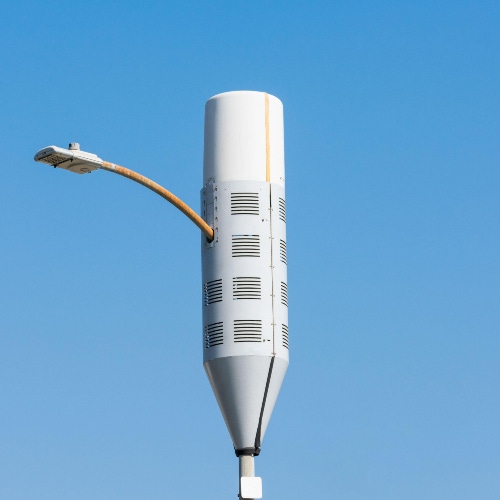MWC Las Vegas speakers endorsed using next-gen repeaters to fill out mmWave coverage instead of throwing more cell sites at the problem.

LAS VEGAS – #MWC22 – The wireless industry's version of range anxiety – the limited reach of millimeter-wave 5G – isn't going away, but equipment vendors are now moving to offer solutions beyond throwing more cell sites at the problem.
Instead, mmWave-minded companies are taking a page from Wi-Fi by developing "smart repeaters" that operate along mesh network principles to fill out coverage that might otherwise stop halfway down a city block or even fail to cover all four corners of an intersection.
"They are not the traditional repeaters that people are used to," said Maryam Rofougaran, CEO and co-founder of Movandi, in a presentation during a two-and-half hour mmWave 5G summit that took place Thursday morning at the MWC Las Vegas trade show.
A new, less obtrusive sight on city streets
She ticked off the advantages of the network add-ons that her Irvine, California, firm has made its specialty: They sync to the nearest cell site, they can be meshed, they can employ beamforming to focus their fill-in signals, they are compact enough to fit unobtrusively atop a streetlight and, in some cases, they can run on solar power alone.
Rofougaran cited an April 2022 report by Mobile Experts that found using smart repeaters cut mmWave deployment costs by 80% in a Dallas neighborhood. The report found that 100 small cell sites augmented by 850 smart repeaters yielded coverage that would have required 950 small cell sites.
"These are real products," she said. "They have been tried by tier-one operators."
Figure 1:  mmWave small cells often sit atop lightpoles.
mmWave small cells often sit atop lightpoles.
(Source: Michael Vi/Alamy Stock Photo)
Verizon, the leading advocate of mmWave 5G in the US, signed up Movandi back in the fall of 2020 to deploy smart repeaters based on its BeamXR technology.
Alex Sinclair, the CTO of the GSMA trade association, gave his own plug for using smart repeaters to address mmWave's "propagation challenges" in a talk that opened the symposium, suggesting that they will be included in a deployment best-practices whitepaper that GSMA plans to publish at the end of October.
Anshel Sag, senior analyst for mobility and VR at Moor Insights & Strategy, called repeaters a sound solution.
"They've become an increasingly important component of expanding mmWave coverage and enabling the cheaper deployment of mmWave," he wrote in an email. "I think that repeaters will be the way forward for operators that want to improve mmWave coverage without running fiber to every gNB [basestation], especially as we start to see mmWave speeds getting up into 5 Gbit/s territory; having 1 Gbit/s repeaters would still be very valuable in dense urban environments."
Sag, however, noted that power will continue to be a problem. He said that telcos hoping to cut deployment costs with solar-powered repeaters could see slower speeds as a result of the technology.
Coping with congestion
Operators will need to make their own judgment calls about what level of service they will need to maintain under network-congestion conditions before making these investments.
Philippe Poggianti, vice president for business development at Qualcomm France, said during the summit that customers may increasingly pay for speedy connectivity in crowded situations.
He cited findings from a survey of some 4,000 respondents across eight countries in July ("they are not techie guys, they are not nerds," he said of the participants) in which more than 25% said their wireless pain points involved different kinds of poor performance in crowds. And 76% said they would pay more to avoid that, whether in the form of a monthly subscription or a shorter one-time speed-boost pass.
And only mmWave, Poggianti said, would keep performance sufficiently high. He cited a December 2021 RootMetrics study that found that in two spots in Chicago, midband 5G slowed from an uncongested download speed of 256.8 Mbit/s to 44.8 Mbit/s bps in congested conditions. mmWave 5G, meanwhile, provided 1932.5 Mbit/s in uncongested environments and 231.4 Mbit/s in congested environments.
"What you need is the millimeter-wave candles at the top of the cake where it makes sense," Poggianti said. His comments were noteworthy because they used the same visual metaphor that T-Mobile has adopted to indicate that mmWave supports hotspots of coverage rather than a full network layer.
Afterwards, Ritesh Mukherjee, senior vice president and general manager of Inseego's 5G enterprise networking business, questioned whether mmWave would be needed in locations where midband 5G services already provide speeds up to 500 Mbit/s. Even if those speeds drop to 100 Mbit/s, that "should be enough for a user on a cell phone roaming about in the city."
But he declined to count out mmWave.
"If it's not today, it will happen sometime in the future," he said. "It will be in cities, in dense locations."
Related posts:
— Rob Pegoraro, special to Light Reading. Follow him @robpegoraro.
About the Author(s)
You May Also Like











